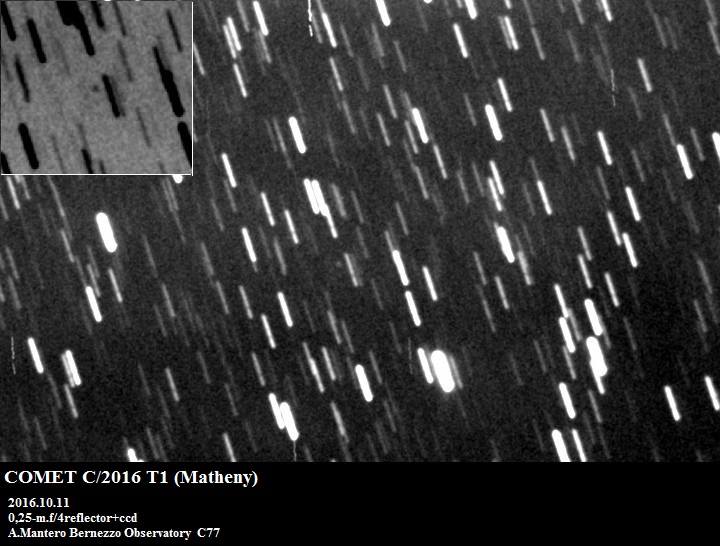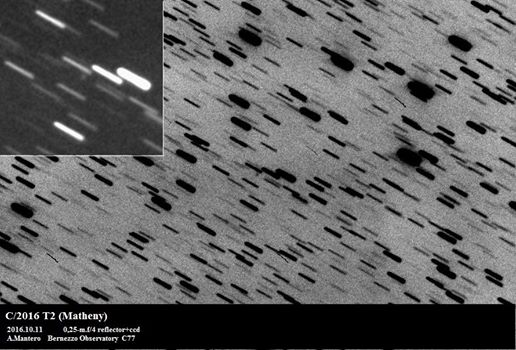Comets discovered in October 2016
C/2016 T1 Matheny
Rose G. Matheny reports the discovery of a comet with a compact, round coma approximately 6"-8" in diameter on CCD images obtained in a sky with poor transparency on Oct. 6 with the 1.5-m reflector in the course of the Mount Lemmon Survey. Follow-up exposures taken by Matheny on Oct. 11.1 UT show a faint broad tail towards p.a. 90-105 deg; the magnitude was then measured to be 18.3-18.4. After the comet was posted on the Minor Planet Center's PCCP webpage, other CCD astrometrists have also commented on the cometary appearance. H. Sato, Tokyo, Japan, writes that exposures taken on Oct. 7.8 with an iTelescope 0.43-m at Nerpio, Spain, shows a strongly condensed coma 6" in diameter and no tail; the w-band magnitude was 17.7 as measured within a circular aperture of radius 3".8. R. Weryk, Institute for Astronomy, University of Hawaii, notes that four i-band exposures taken with the 1.8-m Pan-STARRS1 telescope at Haleakala on Oct. 8.3 shows a short 3" tail towards the south. Stacked images obtained by L. Buzzi, Varese, Italy, with a 0.60-m f/4.64 reflector on Oct. 11.8 show a strong central condensation and a faint coma extended toward the southeast; the red magnitude was measured to be 19.3. (CBET 4328)
Other astronomers confirmed the comet like Andrea Mantero as visible in this nice image:

The available astrometry, the following preliminary parabolic orbital elements by G. V. Williams (from 93 observations spanning Oct. 6-11), and an ephemeris appear on MPEC 2016-T117.
T = 2017 Jan. 30.5997
Peri. = 136.6277
Node = 56.3552
q = 2.315639 AU
Incl. = 129.7776
e=1.0
C/2016 T2 Matheny
R. G. Matheny reports her discovery of another comet on CCD images taken with the Mount Lemmon 1.5-m reflector in haze and moonlight; the object showed a "fuzzy" coma about 10"-12" in diameter with a faint tail towards p.a. 95-100 deg. After the comet was posted on the Minor Planet Center's PCCP webpage, other CCD astrometrists have also commented on the cometary appearance. H. Sato, Tokyo, Japan, used exposures taken with an iTelescope 0.51-m near Mayhill, NM, USA, on Oct. 11.1 UT to find the comet to be strongly condensed with a coma 12" in diameter with no tail; the w-band magnitude was 18.4 as measured within a circular aperture of radius 6".5. R. S. McMillan, University of Arizona, notes that images taken in 3" seeing with the Spacewatch 1.8-m f/2.7 reflector at Kitt Peak on Oct. 11.2 show the comet to be diffuse in individual 60-s exposures. L. Buzzi, Varese, Italy, writes that exposures obtained on Oct. 11.9 with a 0.60-m f/4.6 reflector show the comet's image to be softer with respect to nearby stars. (CBET4330)
The available astrometry, the following preliminary parabolic orbital elements by G. V. Williams (from 72 observations spanning Oct. 10-12), and an ephemeris appear on MPEC 2016-T135.
T = 2016 Dec. 26.3157
Peri. = 90.5774
Node = 339.5151
q = 1.935863 AU
Incl. = 81.7573
e=1.0

C/2016 T3 PANSTARRS
R. Weryk and E. Lilly, report the discovery of another apparent comet in exposures obtained with the 1.8-m Pan-STARRS1 telescope at Haleakala on Oct. 10. (CBET 4331). After the comet was posted on the Minor Planet Center's NEOCP and PCCP webpages, other CCD astrometrists have also commented on the cometary appearance. The available astrometry, the following preliminary parabolic orbital elements by G. V. Williams (from 31 observations spanning Oct. 10-18), and an ephemeris appear on MPEC 2016-U10.
T = 2017 Sept. 6.7452
Peri. = 195.5152
Node = 271.5210
q = 2.622900 AU
Incl. = 22.7521
e=1.0
